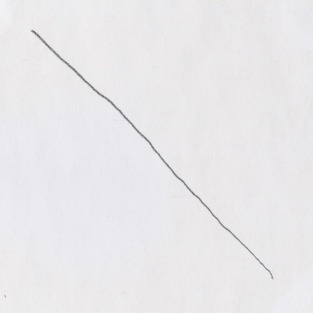Peter Ablinger:
WEISS/WEISSLICH 1
Klavier solo
1.1: Linie absteigend
1.2: Linie aufsteigend (1980), 2'
pno solo, 1.1: white keys descending, 1.2: ascending, 2'

this is the full score
you can also download here: full score
play each note on its own, non legato. duration of one part is about 1 minute. the tempo therefore is about M.M. 36
The figure of the scale, ascending or descending, regularly or irregularly, has been a fixture in Peter Ablinger's music for almost thirty years. Weiss/Weisslich 1 (written in 1980, when the composer was twenty-one) consists entirely of two scales, first descending on the white keys of the piano from the top of the instrument to the bottom, then doing the same in reverse; since then, series of pitches rising or falling by step at a moderate tempo have figured prominently in countless pieces, notably the large-ensemble work Der Regen, der Glas, das Lachen (1994), Grisailles 1-100 (1991-3), and 6 Linien (2004), which has a structure essentially identical to that of 1-127 (2002). More specifically, Ablinger notes in his manifesto-essay "Metaphern" ("Metaphors") that, over the course of several years, he wrote a large number of pieces in which "an instrument steps down its particular range, from top to bottom." This particular gesture, out of which 1-127 was born twenty-five years after Weiss/Weisslich 1, reappears inevitably and obsessively in work after work, and it forms something absolutely fundamental to Ablinger's art.
Clues to the significance of these descending scales, always taking in the entire available compass of the instrument in question, lurk in every corner of Ablinger's thought. He studied graphic design before turning to composition, and even then one of his primary teachers was the visually-minded composer Roman Haubenstock-Ramati. Ablinger writes often of the inextricable connection in his work between music and the graphic arts; in this sense, a scale is an axiomatic stroke of the pencil, the definition of a field. "This line," he has written of his attachment to the scale, "was my personal manifesto of the fundamental."
(Evan Johnson, from: booklet text for "33-127")


Linie absteigend, Linie aufsteigend, Bleistift auf Papier
"In den Jahren 1979/80 schrieb ich in mehreren Fassungen ein Stück für Klavier, dessen einer Teil die weißen Tasten von oben nach unten und der andere von unten nach oben abschreitet. Zwei Vertikalen also. Zwei Linien. Für Bleistift - oder Klavier. Ganz bewußt gesetzt als Alternative zum Denken in Tonsatzkategorien und formalen Dramaturgien. Diese Linie war mein persönliches Manifest für das Grundsätzliche. Später hab ich es als die Nummer eins an die Spitze des Weiss/weisslich-Zyklus gestellt. (Ich hatte das Stück zwar in meinen Werkkatalogen veröffentlicht, und auch gelegentlich Veranstaltern zur Uraufführung angeboten, aber es kam nie dazu, bis es im vergangenen Jahr in einem Konzert in Cal Arts, Los Angeles aufgeführt wurde; Pianist war - wie wunderbar, fast zwingend - der Komponist Michael Pisaro, dessen Bescheidenheit und künstlerische Haltung doch so sehr zu diesem Stück paßt.)"
(Peter Ablinger, aus: "Metaphern", 2004)
(the chapter "Weiss"/"White", from: "Metaphors", 2004)
see also:
> notes on WEISS/WEISSLICH 2
back to: works
 Aljoscha Hofmann \ last edited 29.11.2007
Aljoscha Hofmann \ last edited 29.11.2007